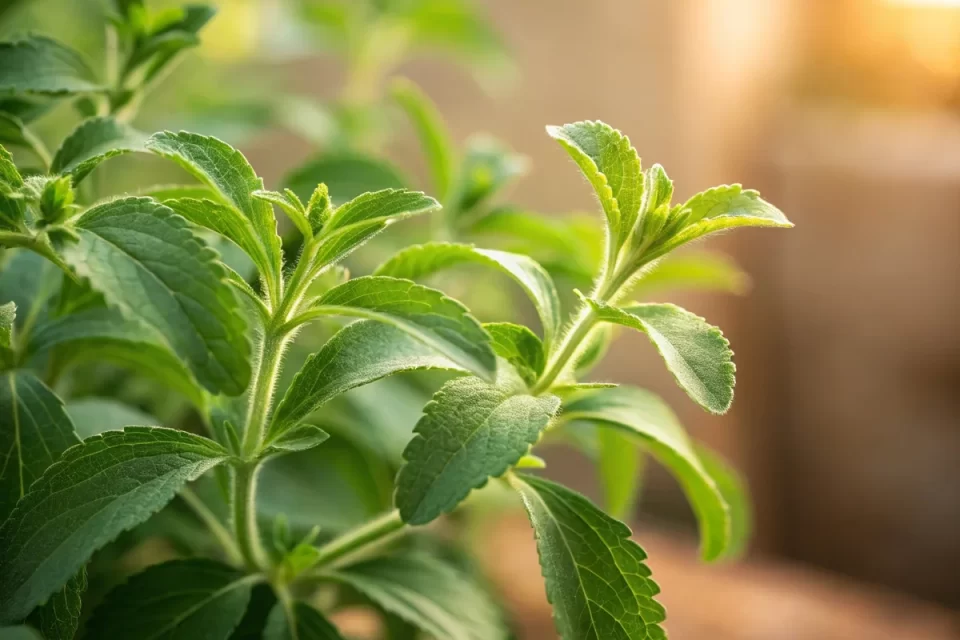Stevia (Stevia rebaudiana), a natural, zero-calorie sweetener derived from a South American plant, has gained popularity as a healthy alternative to sugar and artificial sweeteners. Its intense sweetness and potential health benefits make it a versatile ingredient in modern diets. This article explores stevia’s historical role in food, its nutritional profile, evidence-based health benefits, practical tips for use, and complementary food pairings, supported by scientific research.
History of Stevia in Culinary Traditions
Stevia has been used for centuries by indigenous peoples in South America, particularly the Guaraní of Paraguay and Brazil, who chewed its leaves or used them to sweeten teas and medicines. Known as ka’a he’ê (“sweet herb”) in Guaraní, stevia was documented by Spanish botanist Pedro Jaime Esteve in the 16th century. By the 19th century, stevia was cultivated in Paraguay for local use in beverages and foods. Its global rise began in the 20th century when Japan adopted stevia as a sugar substitute in the 1970s, incorporating it into soft drinks, desserts, and sauces. Today, stevia is widely used worldwide in beverages, baked goods, and processed foods, valued for its natural origin and lack of calories. It appears in everything from American diet sodas to European yogurts and Asian teas, reflecting its universal appeal.
Nutritional Profile
Stevia is a non-nutritive sweetener, meaning it provides negligible calories and macronutrients. Its sweetness comes from steviol glycosides, primarily stevioside and rebaudioside A, which are 200–300 times sweeter than sugar. Per 100 grams of pure stevia leaf extract (though typically used in much smaller amounts, e.g., 1–2g):
- Calories: ~0 kcal
- Protein: 0g
- Fat: 0g
- Carbohydrates: 0g (0g fiber, 0g sugars)
- Vitamins and Minerals:
- Trace amounts of calcium, potassium, and magnesium in whole leaves
- Negligible in refined extracts
- Bioactive Compounds: Steviol glycosides, flavonoids, and minor antioxidants
Note: Nutritional data is based on USDA and industry sources. Most stevia products are highly refined extracts or purified glycosides, used in small quantities, contributing minimal nutrients. Whole stevia leaves may contain trace micronutrients but are less commonly consumed.
Health Benefits
Stevia’s health benefits stem from its zero-calorie nature and bioactive compounds, supported by scientific research. Below are key benefits:
- Blood Sugar Control: Stevia does not raise blood glucose, making it suitable for diabetes management. A study in Appetite (2010) found that stevia preloads reduced post-meal glucose and insulin levels compared to sucrose in healthy adults.
- Weight Management: As a zero-calorie sweetener, stevia supports calorie reduction. A review in Nutrients (2018) suggested that replacing sugar with stevia may aid weight management by reducing overall energy intake without compromising sweetness.
- Cardiovascular Health: Stevia may lower blood pressure. A study in Clinical Therapeutics (2003) showed that stevioside reduced systolic blood pressure by 10–14 mmHg in hypertensive patients after one year.
- Antioxidant Properties: Whole stevia leaves contain flavonoids and phenolic compounds. Research in Journal of Agricultural and Food Chemistry (2011) indicated that stevia leaf extracts exhibit antioxidant activity, potentially reducing oxidative stress.
- Oral Health: Unlike sugar, stevia does not promote tooth decay. A study in Caries Research (2013) found that stevioside inhibited the growth of Streptococcus mutans, a bacteria linked to dental caries.
Note: Benefits vary based on stevia form (whole leaf, extract, or purified glycosides) and dosage. Some individuals may experience a bitter aftertaste with certain stevia products. Consult a healthcare provider before using stevia medicinally, especially for those on diabetes or blood pressure medications.
Tips for Using Stevia
- Choose Quality Products: Opt for pure stevia extracts or whole-leaf powders without additives like maltodextrin or artificial flavors. Check labels for “100% stevia” or “rebaudioside A.”
- Dosage: Stevia is highly potent; use sparingly (e.g., 1/8 tsp of pure extract equals 1 tsp sugar). Follow product-specific conversion charts for accuracy.
- Storage: Store stevia powder or liquid in a cool, dry place in an airtight container for up to 2 years. Whole dried leaves last about 1 year.
- Cooking: Stevia is heat-stable up to 392°F (200°C), suitable for baking, but may not caramelize like sugar. Combine with wet ingredients for even distribution.
- Taste Adjustment: To reduce potential bitterness, pair with acidic ingredients like lemon or use blends with rebaudioside A, which is less bitter than stevioside.
- Moderation: Excessive use may cause mild digestive discomfort in sensitive individuals. Start with small amounts and adjust to taste.
Food Pairings for Stevia
Stevia’s sweetness enhances a variety of foods without adding calories, making it ideal for healthy recipes. Below are five complementary pairings:
- Stevia + Greek Yogurt + Fresh Berries: Sweeten plain Greek yogurt with a pinch of stevia and top with strawberries for a protein-rich, low-sugar breakfast high in antioxidants.
- Stevia + Lemon + Herbal Tea: Add a drop of liquid stevia to chamomile or peppermint tea with a splash of lemon for a calming, hydrating drink rich in vitamin C.
- Stevia + Oatmeal + Cinnamon: Sweeten oatmeal with stevia and a dash of cinnamon for a fiber-packed breakfast that supports blood sugar stability.
- Stevia + Avocado + Cacao: Blend stevia with avocado and unsweetened cacao powder for a creamy, low-sugar chocolate mousse rich in healthy fats.
- Stevia + Pumpkin + Spices: Use stevia in pumpkin smoothies or baked goods with nutmeg and ginger for a nutrient-dense, fall-inspired treat high in vitamin A.
Scientific and Academic Support
Stevia’s benefits are supported by peer-reviewed studies:
- Anton, S. D., et al. (2010). Appetite: Stevia’s effects on glucose and insulin response compared to sucrose.
- Ashwell, M. (2018). Nutrients: Stevia’s role in calorie reduction and weight management.
- Chan, P., et al. (2003). Clinical Therapeutics: Stevioside’s impact on blood pressure in hypertensive patients.
- Tadhani, M. B., et al. (2011). Journal of Agricultural and Food Chemistry: Antioxidant properties of stevia leaf extracts.
- Brandle, J. E., et al. (2013). Caries Research: Stevioside’s inhibition of caries-causing bacteria.
These studies confirm stevia’s potential for blood sugar control, weight management, and other health benefits, though long-term safety and optimal dosages require further research.

